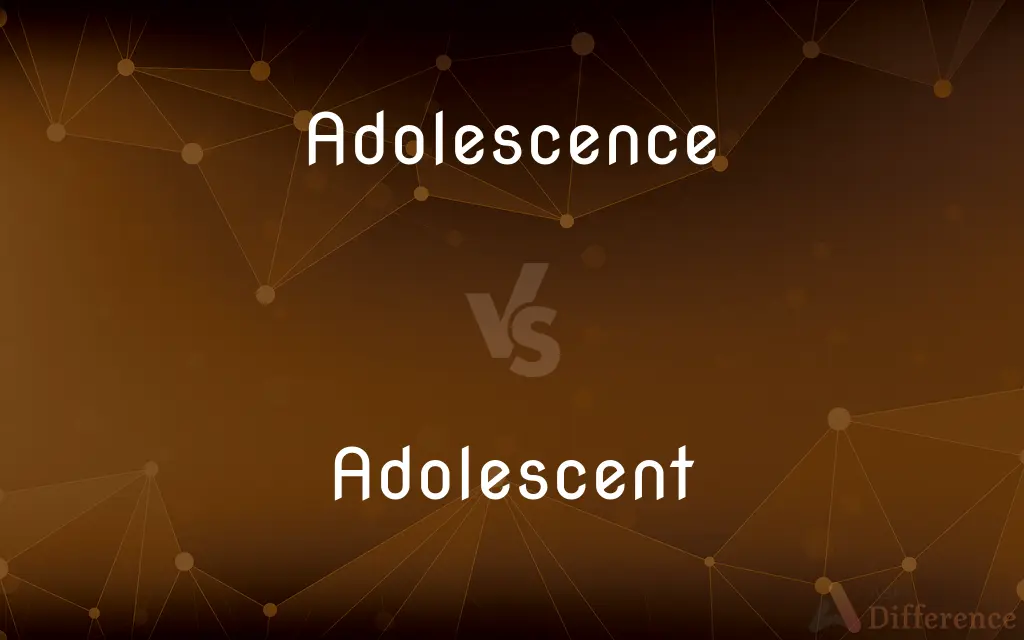Adolescence vs. Adolescent — What's the Difference?
By Fiza Rafique & Urooj Arif — Updated on February 27, 2024
Adolescence is a developmental phase between childhood and adulthood, marked by physical, psychological, and social changes. An adolescent is an individual in this phase, typically between ages 13 and 19.

Difference Between Adolescence and Adolescent
Table of Contents
ADVERTISEMENT
Key Differences
Adolescence represents a critical period of growth and development that spans the teenage years, generally considered to be from 13 to 19 years of age. It's characterized by significant physical, emotional, and cognitive changes as children transition into adulthood. An adolescent, on the other hand, is a person who is currently experiencing this stage. This distinction is crucial for understanding the difference between discussing the phase itself and referring to individuals going through this phase.
During adolescence, individuals undergo puberty, which brings about physical changes such as growth spurts and the development of secondary characteristics. When talking about an adolescent, these changes are personalized and vary greatly from one individual to another, highlighting the uniqueness of each person's experience during this time.
Adolescence is marked by the search for identity, independence, and a sense of self. Adolescents, as individuals, may struggle with self-esteem, peer relationships, and emotional regulation. This period is critical for the development of personal values and beliefs.
Adolescence involves changes in relationships with parents, peers, and society. Adolescents are navigating their social identities, experiencing more intense and diverse social interactions, and often seeking autonomy. This stage is pivotal for establishing social skills and independence.
The end of adolescence is often associated with reaching adulthood, which can vary by country. For an adolescent, reaching legal adulthood may involve new rights and responsibilities, such as voting or driving, marking a significant milestone in their development.
ADVERTISEMENT
Comparison Chart
Definition
A developmental phase
An individual in the developmental phase
Age Range
Typically 13-19 years
Any person within the 13-19 age range
Focus
Physical, psychological, social changes
Experiencing physical, psychological, social changes
Psychological Aspect
Identity formation, independence
Personal struggle with self-esteem, relationships
Social Aspect
Changes in relationships, social identity formation
Navigating social interactions, seeking autonomy
Compare with Definitions
Adolescence
The end of adolescence is marked by reaching adulthood.
The transition out of adolescence varies across cultures.
Adolescent
An adolescent is someone experiencing the transition to adulthood.
An adolescent may face challenges in school due to emotional changes.
Adolescence
It encompasses mental and emotional development.
Adolescence is crucial for developing a sense of self.
Adolescent
Adolescents work towards independence.
The adolescent started a part-time job to earn his own money.
Adolescence
Adolescents begin to form their identity.
Many explore different roles and beliefs during adolescence.
Adolescent
Emotional and social development is key for an adolescent.
The adolescent is forming new friendships that reflect her personal values.
Adolescence
Adolescence is the transition period from childhood to adulthood.
Adolescence involves significant growth spurts.
Adolescent
Adolescents undergo puberty, leading to physical changes.
The adolescent was taller than his peers due to an early growth spurt.
Adolescence
Social relationships evolve during adolescence.
Peer influence becomes more significant in adolescence.
Adolescent
Legal adulthood brings new rights for the adolescent.
The adolescent voted for the first time after turning 18.
Adolescence
Adolescence (from Latin adolescere 'to grow up') is a transitional stage of physical and psychological development that generally occurs during the period from puberty to legal adulthood (age of majority). Adolescence is usually associated with the teenage years, but its physical, psychological or cultural expressions may begin earlier and end later.
Adolescent
A young person who has undergone puberty but who has not reached full maturity.
Adolescence
The period of physical and psychological development from the onset of puberty to adulthood.
Adolescent
Of, relating to, or undergoing adolescence.
Adolescence
A transitional period of development between an initial or early phase and an established or mature phase
The adolescence of a nation.
Adolescent
Characteristic of adolescence; immature
An adolescent sense of humor.
Adolescence
The transitional period of physical and psychological development between childhood and maturity.
During adolescence, the body and mind go through many complex changes, some of which are difficult to deal with.
Adolescent
Of, relating to, or at the age of adolescence; at the stage between being a child and an adult.
Adolescence
The time period between the beginning of puberty and adulthood
Adolescent
A person who is in adolescence; someone who has reached puberty but is not yet an adult.
Adolescence
In the state that someone is in between puberty and adulthood
Adolescent
In the state of development between puberty and maturity;
Adolescent boys and girls
Common Curiosities
Can the duration of adolescence vary between individuals?
Yes, the onset and conclusion of adolescence can vary greatly among individuals.
What are some common challenges adolescents face?
Adolescents often face challenges related to self-esteem, peer pressure, and identity formation.
At what age does adolescence typically start and end?
Adolescence typically starts around 13 and ends around 19.
Why is adolescence considered a critical developmental stage?
It's marked by significant physical, psychological, and social changes crucial for transitioning into adulthood.
What is the main difference between adolescence and an adolescent?
Adolescence is a phase of development, while an adolescent is an individual experiencing this phase.
What are the legal implications of reaching the end of adolescence?
Reaching legal adulthood comes with new rights and responsibilities, like voting or driving.
How do adolescents develop a sense of identity?
Through exploration, personal experiences, and social interactions.
How does adolescence affect family dynamics?
Adolescents seeking independence may challenge family dynamics, requiring adjustments in parenting styles.
What role do peers play in an adolescent's development?
Peers significantly influence social skills, self-esteem, and identity.
How does adolescence influence career choices?
Experiences and interests developed during adolescence can significantly influence future career paths.
What are the educational implications of adolescence?
Adolescents may face academic pressures, making educational support and understanding crucial.
Is it normal for adolescents to experience mood swings?
Yes, due to hormonal changes and psychological development, mood swings are common.
How can parents support their adolescents during this phase?
By providing guidance, support, and understanding, and respecting their growing need for independence.
What health concerns are associated with adolescence?
Mental health issues, substance abuse, and nutritional concerns are common challenges during this stage.
How do cultural differences impact the experience of adolescence?
Cultural norms and values shape the adolescence experience, influencing identity formation and social interactions.
Share Your Discovery

Previous Comparison
Lever vs. Fulcrum
Next Comparison
Old vs. ShabbyAuthor Spotlight
Written by
Fiza RafiqueFiza Rafique is a skilled content writer at AskDifference.com, where she meticulously refines and enhances written pieces. Drawing from her vast editorial expertise, Fiza ensures clarity, accuracy, and precision in every article. Passionate about language, she continually seeks to elevate the quality of content for readers worldwide.
Co-written by
Urooj ArifUrooj is a skilled content writer at Ask Difference, known for her exceptional ability to simplify complex topics into engaging and informative content. With a passion for research and a flair for clear, concise writing, she consistently delivers articles that resonate with our diverse audience.















































